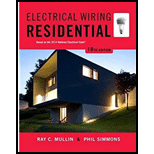
Concept explainers
a.
Whether is it necessary to add air-conditioner load and electric heating load to obtain the combined load on the system.
a.
Answer to Problem 1R
No, it is not necessary to add air-conditioner load and electric heating load to obtain the combined load on the system.
Explanation of Solution
Description:
From NEC 220.60, it is not necessary to add air-conditioner load and electric heating load to obtain the combined load on the system.
Conclusion:
No, it is not necessary to add air-conditioner load and electric heating load to obtain the combined load on the system.
b.
Explain the reason why it is not necessary to add air-conditioner load and electric heating load to obtain the combined load on the system.
b.
Explanation of Solution
Description:
The National Electrical Code (NEC) is the basic standard code and it sets the standards for
From NEC 220.60, the noncoincident loads such as electric heating and air-conditioner are not operated at the same time. Therefore, when calculating the feeder value that is used to supply both the loads, the larger value of loads can be considered.
Therefore, it is not necessary to add air-conditioner load and electric heating load to obtain the combined load on the system.
Conclusion:
Thus, the reason why it is not necessary to add air-conditioner load and electric heating load to obtain the combined load on the system is explained.
Want to see more full solutions like this?
Chapter 23 Solutions
Electrical Wiring: Residental - With Plans (Paperback) Package
- Don't use ai to answer I will report you answer. Please give explanation for both correct options and incorrectarrow_forward14:00 APP Voi) 5G 鼷浴醵郯興47% atheva.cc/index/index/index.html The Most Trusted, Secure, Fast, Reliable Cryptocurrency Exchange Get started with the easiest and most secure platform to buy, sell, trade, and earn Cryptocurrency Balance:1000.00 Recharge Withdraw Message About us BTC/USDT ETH/USDT EOS/USDT 83259.00 1841.46 83259.00 +1.02% +0.08% +1.02% Operating norms Symbol B BTC/USDT Latest price 24hFluctuation 83259.00 +1.02% ETH/USDT 1841.46 +0.08% B BTC/USD illı 83259.00 +1.02% Home Markets Trade Record Mine О <arrow_forwardPastner Brands is a calendar-year firm with operations in several countries. As part of its executive compensation plan, at January 1, 2024, the company issued 480,000 executive stock options permitting executives to buy 480,000 shares of Pastner stock for $38 per share. One-fourth of the options vest in each of the next four years beginning at December 31, 2024 (graded vesting). Pastner elects to separate the total award into four groups (or tranches) according to the year in which they vest and measures the compensation cost for each vesting date as a separate award. The fair value of each tranche is estimated at January 1, 2024, as follows: Vesting Date Amount Fair Value Vesting per Option: December 31, 2024 25% $ 3.90 December 31, 2025 25% $ 4.40 25% $ 4.90 25% $ 5.40 December 31, 2026 December 31, 2027 Required: 1. Determine the compensation expense related to the options to be recorded each year 2024-2027, assuming Pastner allocates the compensation cost for each of the four…arrow_forward
- JOB UPDATE Apply on- Jobswood.com OR Search "Jobswood.com" on Google COMPANY JOB PROFILE JOB LOCATION WEB ENGINEER GOOGLE MULTIPLE CITIES (FRESHERS) AMAZON SOFTWARE DEV ENGG MULTIPLE CITIES COGNIZANT SYSTEMS ENGINEER CHENNAI ZENSAR FRONTEND DEVELOPER BENGALURU ORACLE AUTOMATION ENGINEER BENGALURU DIGITAL OCEAN SUPPORT ENGINEER HYDERABAD IBM APPLICATION DEVELOPER HYDERABAD INDIAMART WORK FROM HOME MULTIPLE CITIES AMAZON RECRUITER HYDERABAD GE HEALTHCARE TRAINEE ENGINEER BENGALURUarrow_forwardJOB UPDATE Apply on Vinkjobs.com OR Search "VinkJobs.com" on Google Company Name Job Profile Job Location CISCO Software Engineer Bengaluru Accenture Associate (Freshers) Chennai Trellix Developer Bengaluru Verizon SDET Bengaluru Allerin Test Engineer Mumbai Sutherland SQL/.Net Developer Chennai Bottomline DevOps Engineer Multiple Cities IQVIA HRIS Specialist Bengaluru BYJU's Associate Multiple Cities Spring Works Executive WFH (Remote)arrow_forwardDon't use ai to answer I will report you answerarrow_forward
 EBK ELECTRICAL WIRING RESIDENTIALElectrical EngineeringISBN:9781337516549Author:SimmonsPublisher:CENGAGE LEARNING - CONSIGNMENT
EBK ELECTRICAL WIRING RESIDENTIALElectrical EngineeringISBN:9781337516549Author:SimmonsPublisher:CENGAGE LEARNING - CONSIGNMENT
